Wood screws are a vital component in any woodworking project; they provide a secure and durable fastening solution.
Sadly, not all wood screws are the same, so it is imperative to select the right type to avoid dreadful outcomes.
From splitting wood to weak connections, using the wrong screw compromises the structural integrity of your project and even impacts its aesthetic appeal.
That’s why it’s crucial to understand the different types of wood screws available and choose the correct one for your specific needs.
What Are Wood Screws?
If you’ve ever worked on a woodworking project, you’re probably familiar with wood screws.
Wood screws are a type of fastener specifically designed for use with wood. They feature a sharp, tapered point that allows them easily penetrate wood fibres and a threaded shaft that helps them grip the wood to provide a secure hold.
The head of the screw can have various forms – flat, round, or oval – and is usually crafted to be even with the wood’s surface. Screws are made from materials like steel or brass and come in various shapes and sizes.
Common Materials Used In The Manufacture Of Wood Screws
Different materials are used to build screws, each offering distinct characteristics that make them apt for specific uses.
1. Steel
Steel is the most commonly used material for making wood screws. It is a strong, durable, affordable material that can withstand heavy loads and stress.
Steel screws corrode over time especially when exposed to moisture. As a result, they are not recommended for outdoor use, where they are likely to be exposed to rain, snow, and other forms of precipitation.
2. Stainless Steel
Stainless steel screws are ideal for outdoor use due to their corrosion & rust resistance.
This is achieved through the combination of iron and chromium alloy that forms them, granting them such properties. Chromium produces an imperceptible layer of protection which is capable of self-repair if oxygen gets in contact with the surface.
The layer allows the material to endure damage and can be a great asset to individuals looking for durability.
3. Brass
These eye-catching golden brass screws are perfect for projects that require a touch of class. They offer rust-proof protection and can also withstand certain levels of wear & tear but should not be used for heavier-duty tasks as they may not be as strong as steel screws.
4. Bronze
Bronze is composed of copper, tin, and a few other elements. Its inherent composition makes it much more robust compared to other metals.
Screws made from bronze are more expensive than steel screws but are worth the investment in applications that require high strength and durability.
5. Aluminum
As aluminum screws are light in weight, they are a great choice for applications where this property matters.
Even though they can corrode, they don’t rust and hence are widely used in the car industry, medical units, and aerospace engineering where limiting weight is critical.
These fasteners also have an aesthetically pleasing look. Their robustness ensures they remain in great condition over the long run.
6. Titanium
Screws in particular are usually crafted out of titanium to provide maximum strength when weight is a critical factor.
Although they cost more than basic screws, investing in high-performance fasteners pays off, especially if you need them for specialized applications.
Why It’s Important To Use The Correct Type Of Screw
1. Prevents Damage to the Wood
Using the wrong type of screw can cause damage to the wood like splitting or cracking which weakens the overall structure of the project.
2. Ensures Structural Integrity
Knowing which screws to use for different projects is crucial for ensuring a secure hold & maintaining structural integrity.
This is especially relevant in areas that require strong attention to safety like construction and woodworking.
3. Improves the Appearance of the Finished Product
Selecting the appropriate screws can bolster your product’s appearance significantly. Making sure they are embedded in the wood, instead of protruding outward, makes them less noticeable and leaves a sleek, polished finish.
How To Choose The Right Wood Screws
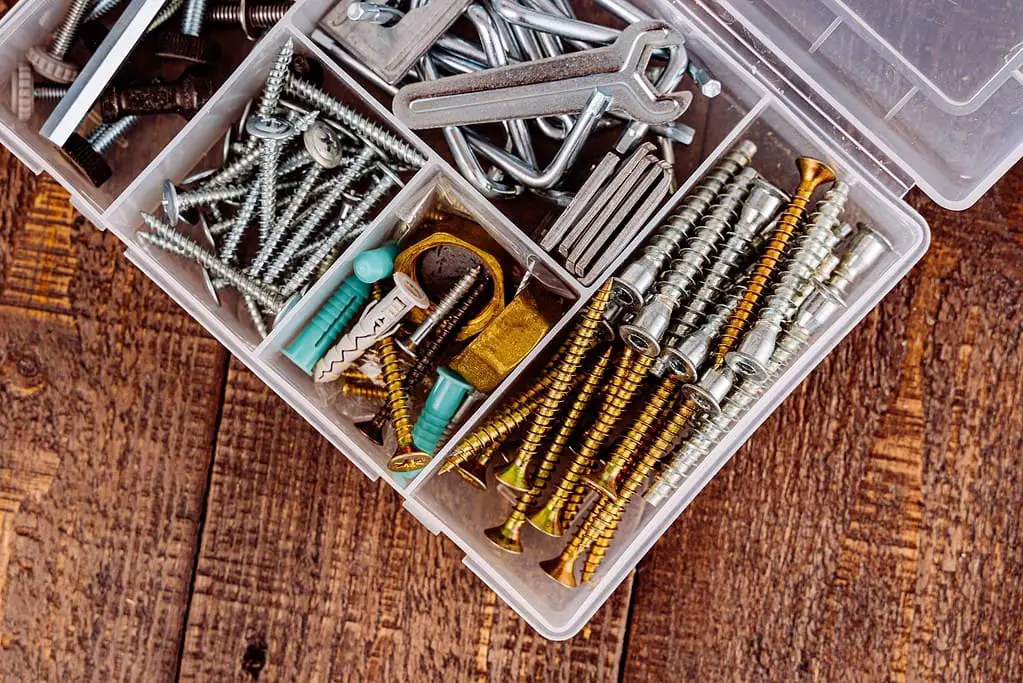
With a wide array of screws available, selecting the right one for your project can be daunting. There are several considerations to take into account when choosing wood screws including:
1. Type of Wood
The type of wood you’re working with is one of the most important factors to consider when choosing screws.
Softwoods like pine or spruce are less dense and require shorter and thinner screws than hardwoods like oak or maple. Coarse thread screws are more suitable for use in softwoods, and fine thread screws are a better choice for hardwoods.
With their tight threads that include many threads per inch, hardwood screws make it less likely for the wood to split.
Likewise, using fewer threads per inch on softwood screws lessens its chances of splitting wood fibers.
2. Length & Diameter of Screw
To ensure maximum strength and support, screws need to be of the right size. Too short or too thin screws can’t provide enough stability while too long or too thick ones can easily cause splitting and cracking in the wood.
3. Strength Requirements
Also, consider the strength of the screws you’re using. For heavy-duty projects such as constructing a deck or a furniture piece that will carry a lot of weight, choose screws with enough strength for the burden.
10 Types Of Wood Screws & When To Use Them
To simplify the various types of screws and their usage, we have created a list that’d help you figure out which screw to use for each job.
1. Philips Head Screws
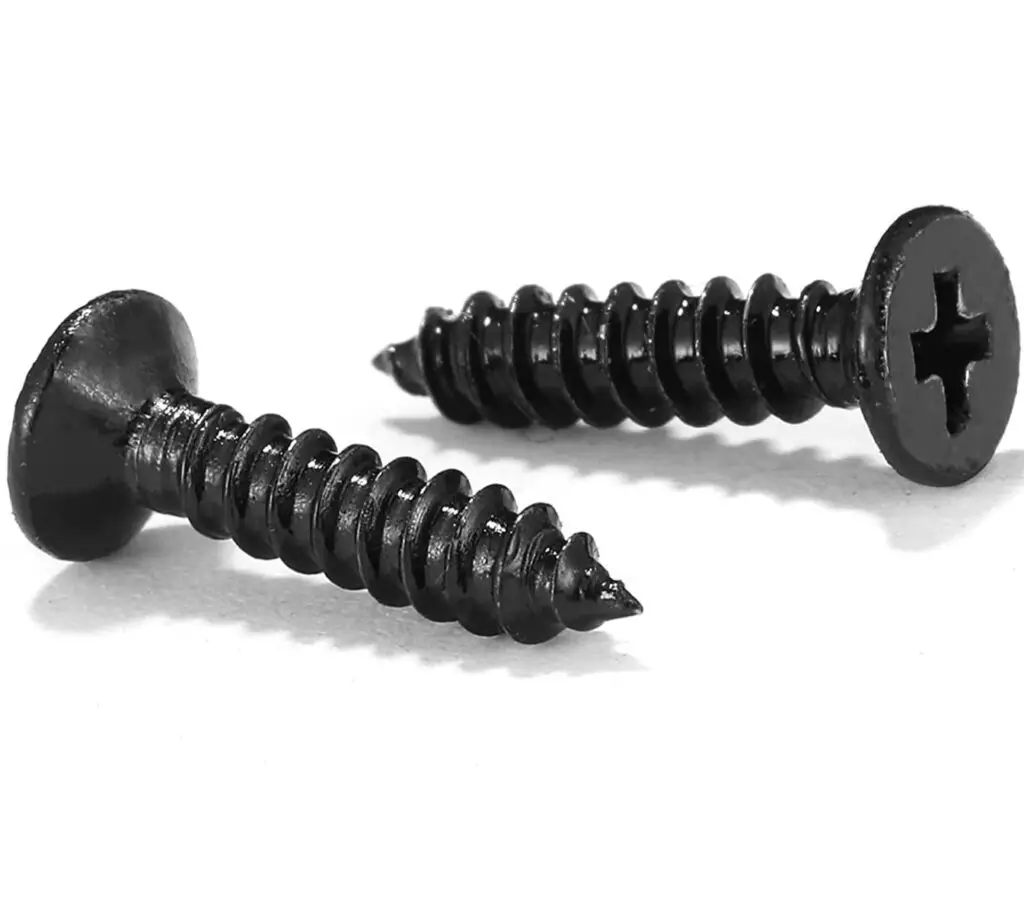
Philips screws also known as cross-head screws are a popular type of screw with a cruciform or “+”-shaped recessed slot in the head of the screw, which requires a Phillips screwdriver to install. They are one of the most commonly used screws and are available in various sizes, lengths, and materials.
The primary advantage of the Philips screw is that it allows for greater torque to be applied to the screw without causing the driver to slip or cam out of the screw head. This is due to the recessed slot’s tapered and slightly curved design which allows for a better grip on the screwdriver blade. The tapered shape centers the driver in the slot while reducing the likelihood of the driver slipping out of the slot.
When to Use Philips Head Screws
Philips head screws are ideal for general-purpose applications including furniture assembly, framing, and cabinet making.
The screws provide a versatile solution for woodworkers because they can be used in drywall and many other structural fixings.
This type of screw is an ideal choice for a variety of DIY tasks around the home.
2. Torx Drive Screws
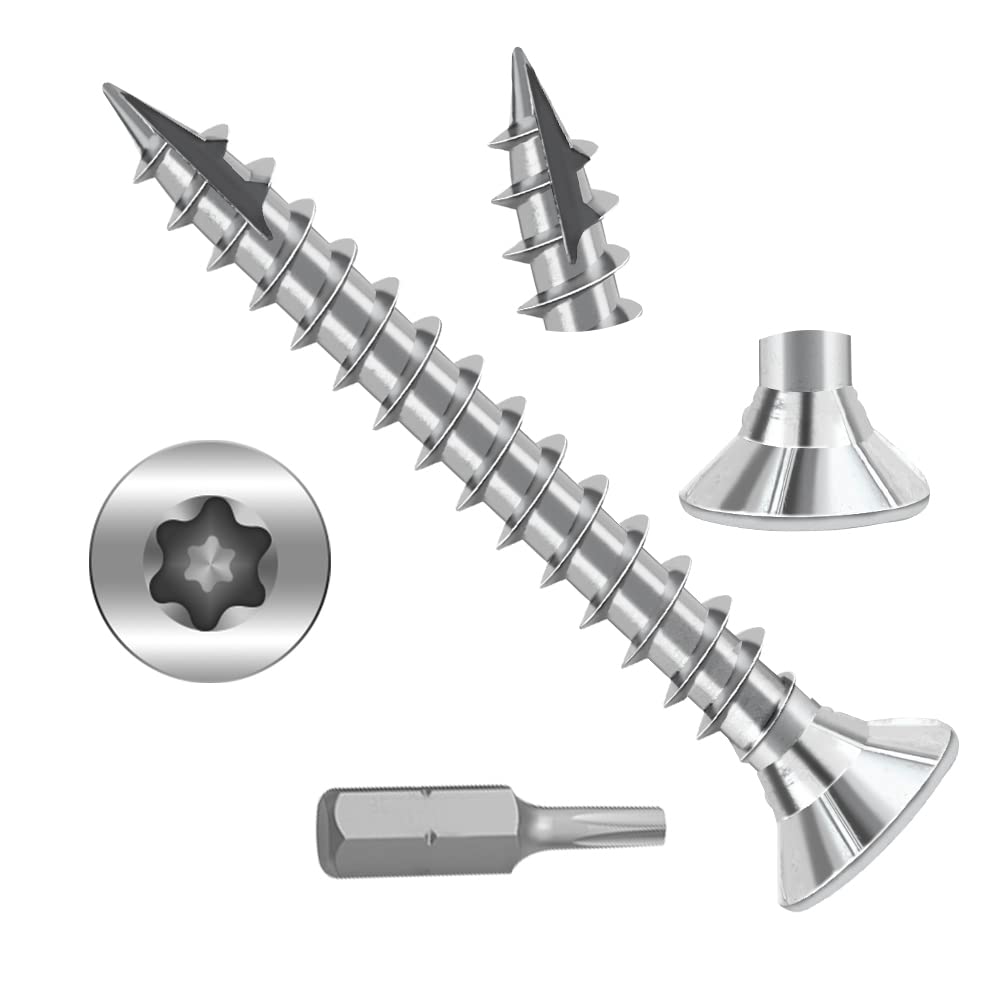
Torx drive screws also known as star drive screws are a type of screw with a six-pointed star-shaped recessed slot in the head of the screw, which requires a Torx screwdriver to install.
With their six-pointed star-shaped recessed slot, they efficiently get the job done without slipping, camming out, or causing damage to themselves or the wood.
They’re high-torque heroes that handle any challenge you throw their way. They are worth seeking out for those who appreciate a long-lasting connection between two pieces of material.
When To Use Torx Drive Screws
Torx drive screws are ideal for high-stress applications like decking, fencing, and outdoor furniture.
3. Self-Tapping Screws
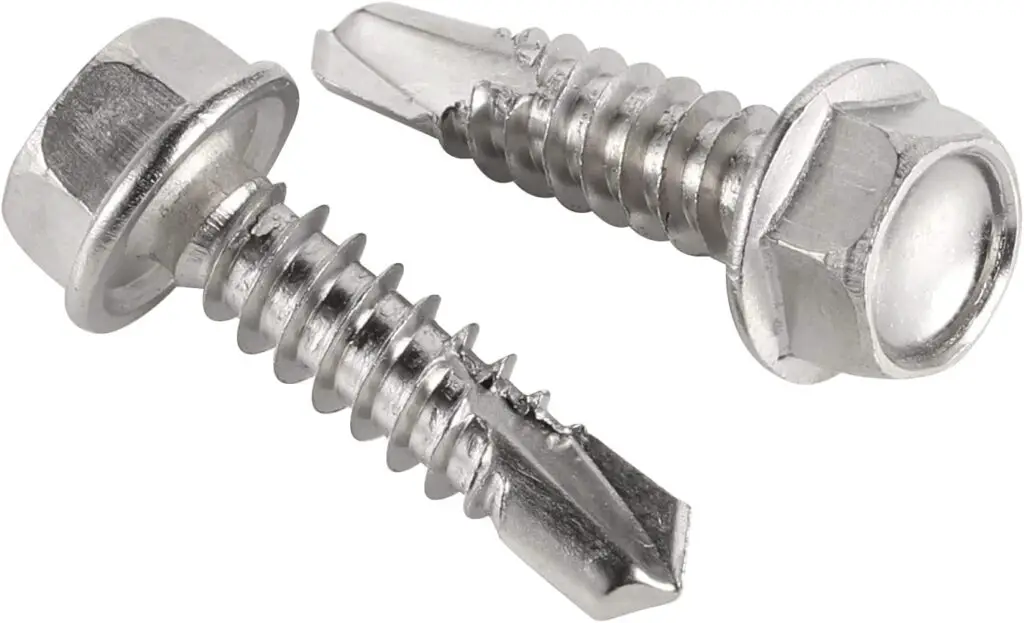
Self-tapping screws are designed with a sharp, pointed tip so they can easily drill into wood surfaces without pre-drilling any holes.
This is especially useful for situations where traditional drilling methods would be impractical or impossible. Threads on the shafts are crafted to give a tighter fit than regular screws but they can be quite difficult to remove once they are set in place.
Nonetheless, their secure grip ensures an improved performance as compared to screws.
When To Use Self-Tapping Screws
Self-tapping screws are commonly used in construction and woodworking projects that require attaching metal or hinges to wood.
4. Decking Screws

Decking screws are a great choice for any outdoor deck project. They can also be used in other situations, but they’re best suited for working on decks.
Their custom head & shaft design helps them stay firmly in place while also resisting corrosion over time. This makes them a popular choice for use in outdoor projects, where exposure to the elements can cause other types of screws to fail. Decking screws come in various lengths, diameters, and materials.
When To Use Decking Screws
Deck screws are a must-have for constructing decks; they securely affix boards and other components of the deck together. The screws can be used to construct framing and even install rails.
5. Dowel Screws
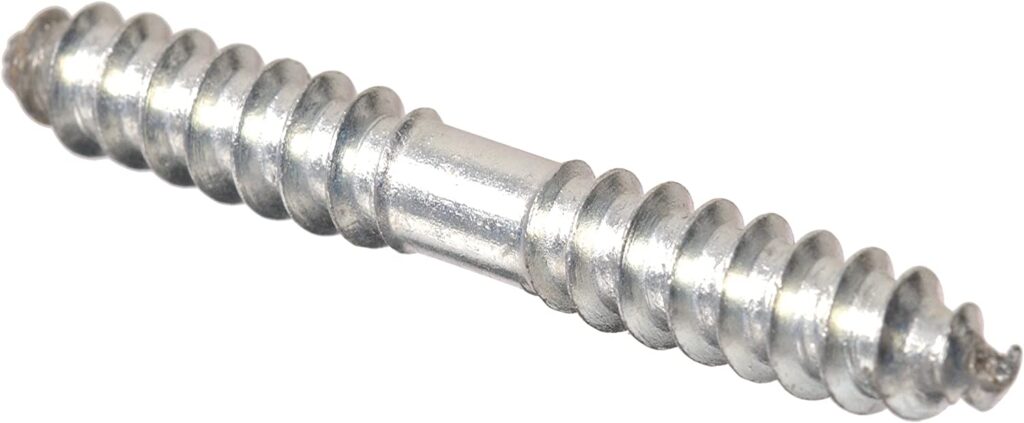
Dowel screws are a type of screw that is inserted into two separate pieces of material to join them together.TThey have threaded shafts on both ends made to fit into a pre-drilled hole. This allows the screw to create a secure connection between the two pieces of material without the need for additional hardware.
When to Use Dowel Screws
The screws are used as a fastening method for joining two pieces of wood together. They provide a sturdy and invisible wood-to-wood connection.
6. Drywall Screws
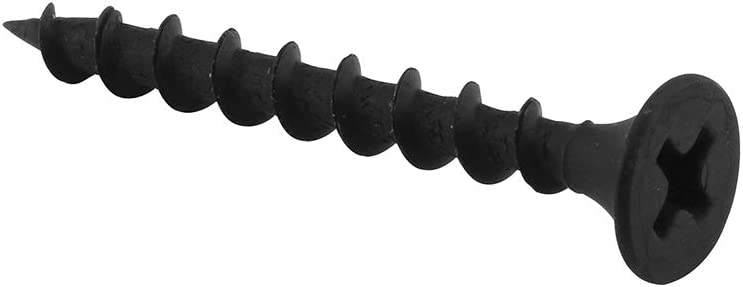
Drywall screws have a fine thread and a bugle head that is designed to sink into the drywall surface. They can be easily inserted into drywall using a power drill or screwdriver, and their tapered heads help to create a smooth, flush finish.
Drywall screws do come in two types – coarsely-threaded and finely-threaded screws. Drywall to wood studs requires coarse-threaded screws while attaching drywall to metal studs necessitates finely-threaded screws.
When To Use Drywall Screws
Drywall screws are an excellent choice when mounting drywall to either wood or metal studs.
7. Lag Screws
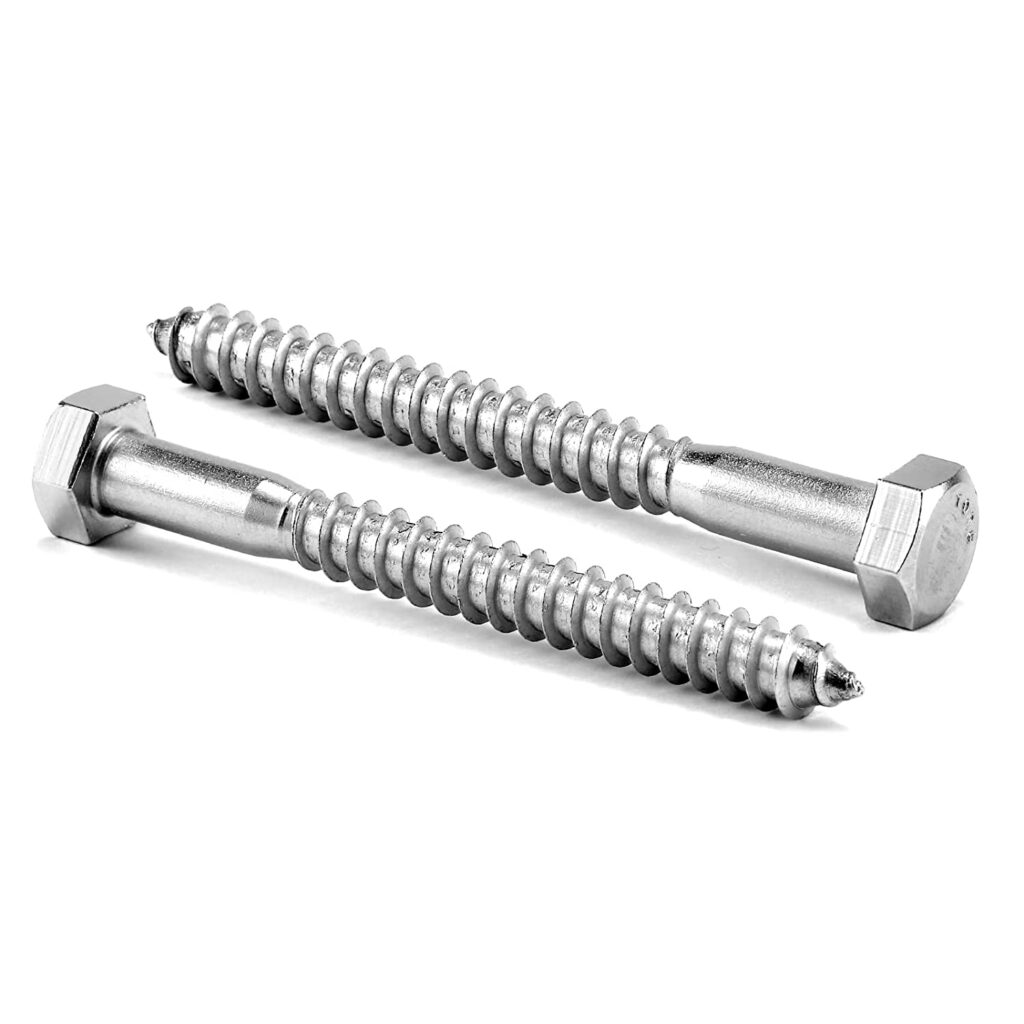
They are generally larger and thicker than other types of screws; with a hexagonal head that allows them to be tightened or loosened with a ratchet or nut driver.
One of the key benefits of lag screws is their strength. Lag screws are made from hardened steel or other strong materials that can withstand heavy loads and resist bending or breaking.
Furthermore, their larger size and thicker shank can help to provide added strength and support.
When To Use Lag Screws
Lag screws are used to attach heavy objects such as furniture, machinery, or equipment to wood or other materials.
The screws provide a strong and reliable connection even in high-stress applications.
They can also be used to connect posts or beams to wood or concrete surfaces. These screws are perfect for other projects including fence panels and deck boards.
8. Pocket Screws
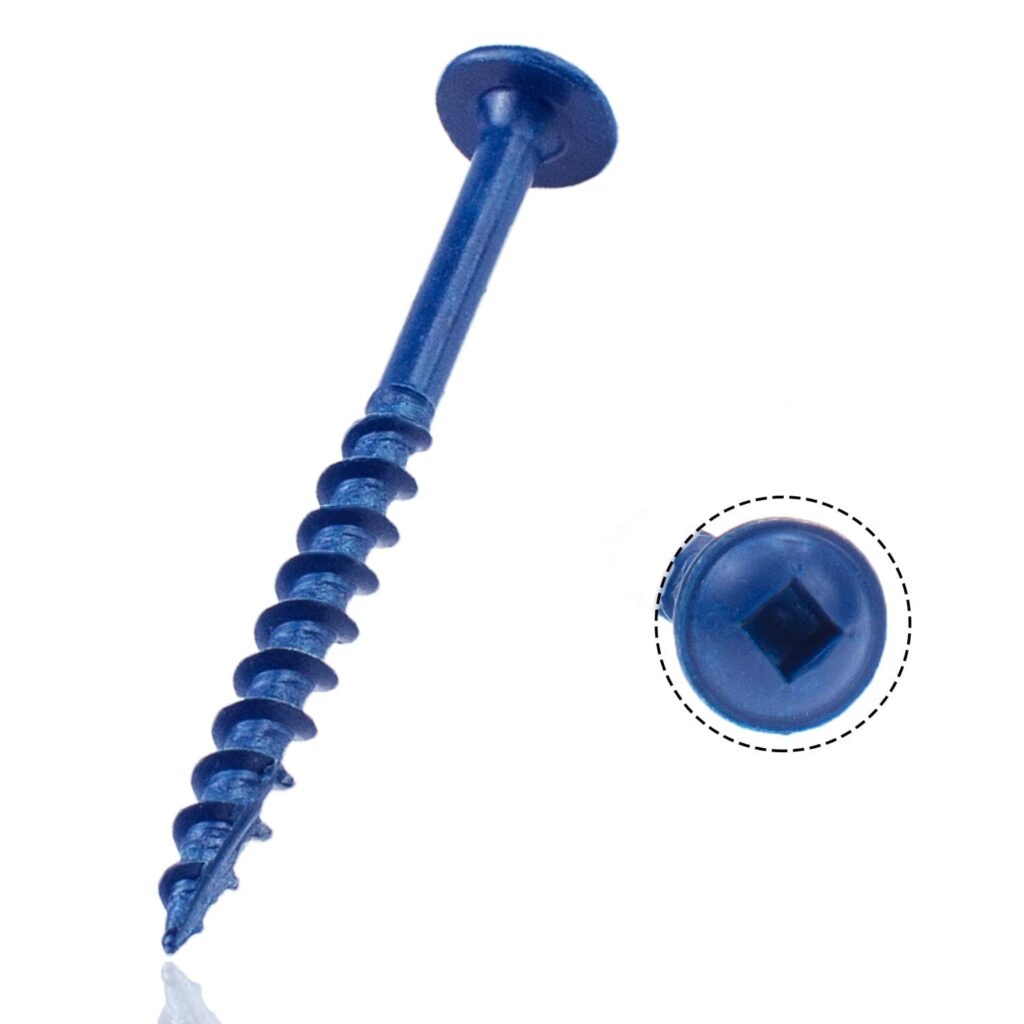
These screws are specially designed to work with pocket holes which are created using a pocket hole jig – the pocket hole jig creates a 15-degree angle hole that allows the screw to be inserted.
You can use angled holes and specialized screws to create invisible joints between two pieces of wood. They blend seamlessly while providing vital support to the structure they’re holding together.
When To Use Pocket Screws
Pocket screws are often used in cabinetry and furniture-making. They are great for joining pieces of wood at an angle, and their unique design allows for a strong joint that can hold up over time.
They are also easy to use so they are popular for projects.
9. MDF Screws
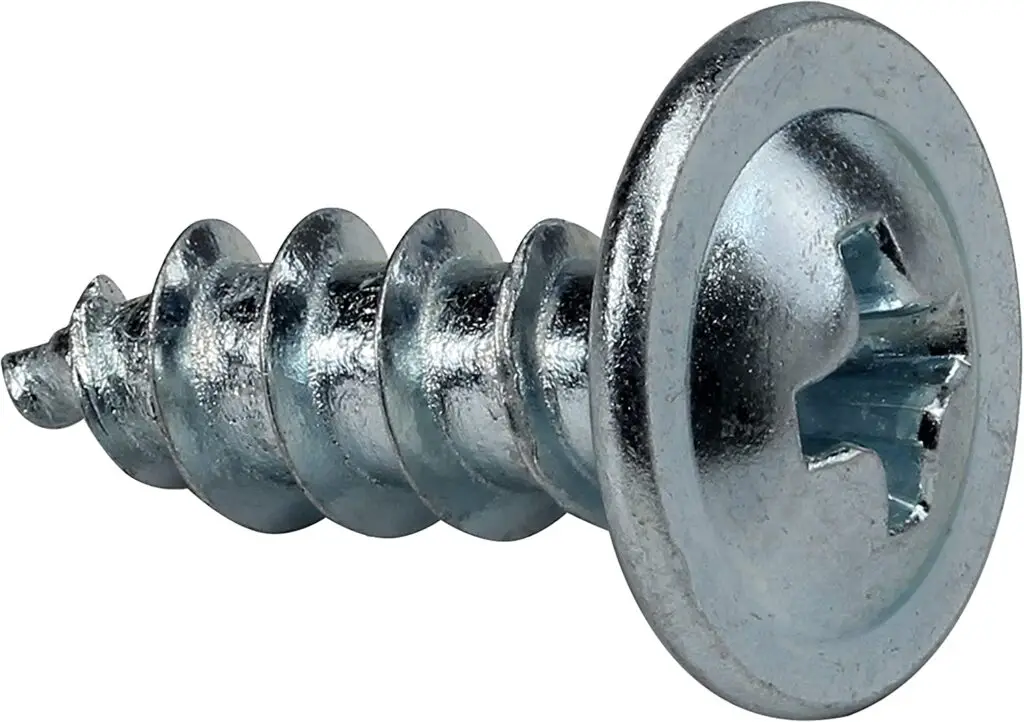
MDF screws are specifically crafted to perfectly fit medium-density fiberboard (MDF); an engineered wood material.
These screws are made from steel or other materials and feature a deep thread design that securely fastens the MDF without splitting it. MDF screws sit flush with the surface of the wood to give a tidy finish.
When To Use MDF Screws
MDF screws are designed to be used specifically with medium-density fiberboard and aren’t usually recommended for other kinds of wood.
People use them a lot in making furniture and cabinets which involve MDF as well as creating shelves or any other types of storage.
10. Hex Head Screws
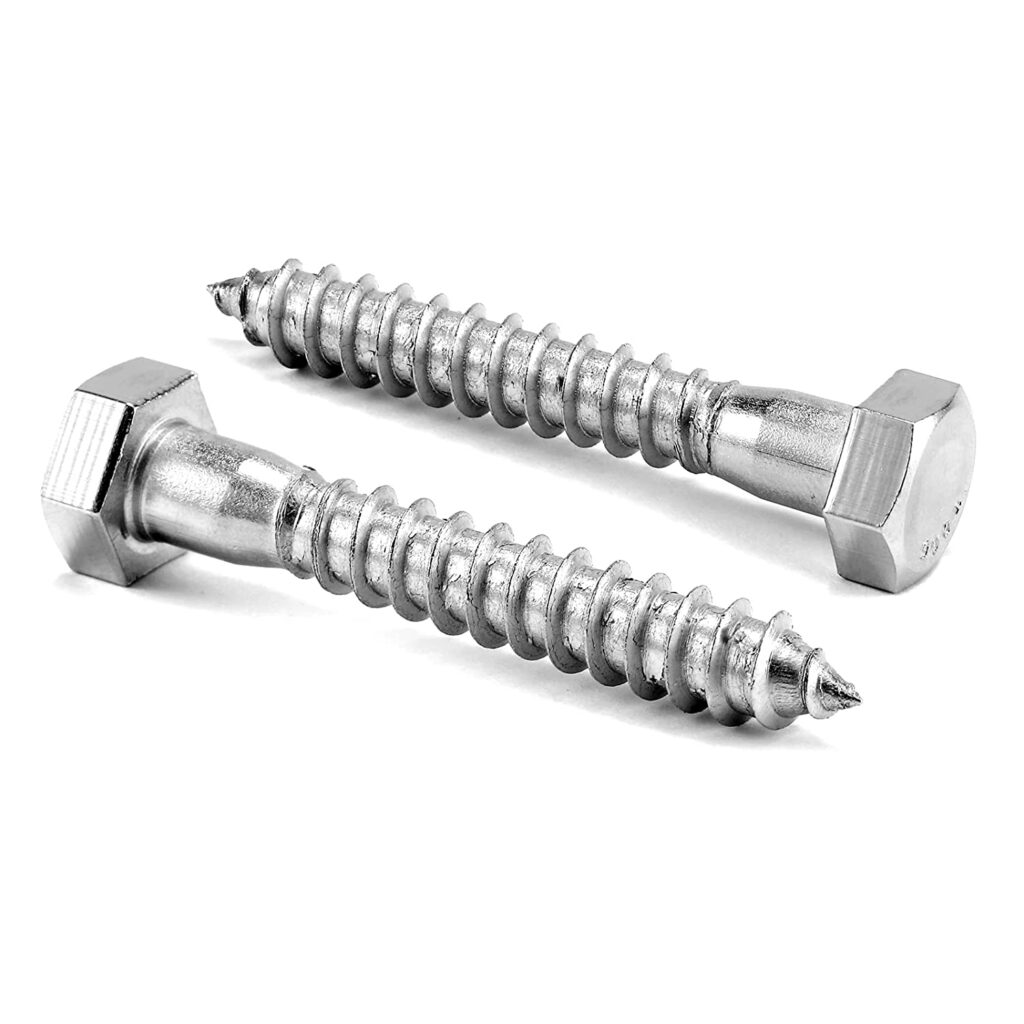
Hex head screws feature a hexagon-shaped head and threaded shank which is pre-drilled into the wood to ensure a secure fit.
This type of fastener is easier to tighten or loosen with a wrench or socket due to its unique design. Plus, they also provide more surface area contact than other similar types of fasteners for improved clamping power.
Hex head screws are available in different lengths and sizes, and they can be used with diverse wood types.
When To Use Hex Head Screws
These specific screws are frequently used for roofing, flooring, and other structural works requiring load-bearing support. They offer a secure joint that can stand up to whatever challenges may arise.
Tips For Working With Wood Screws
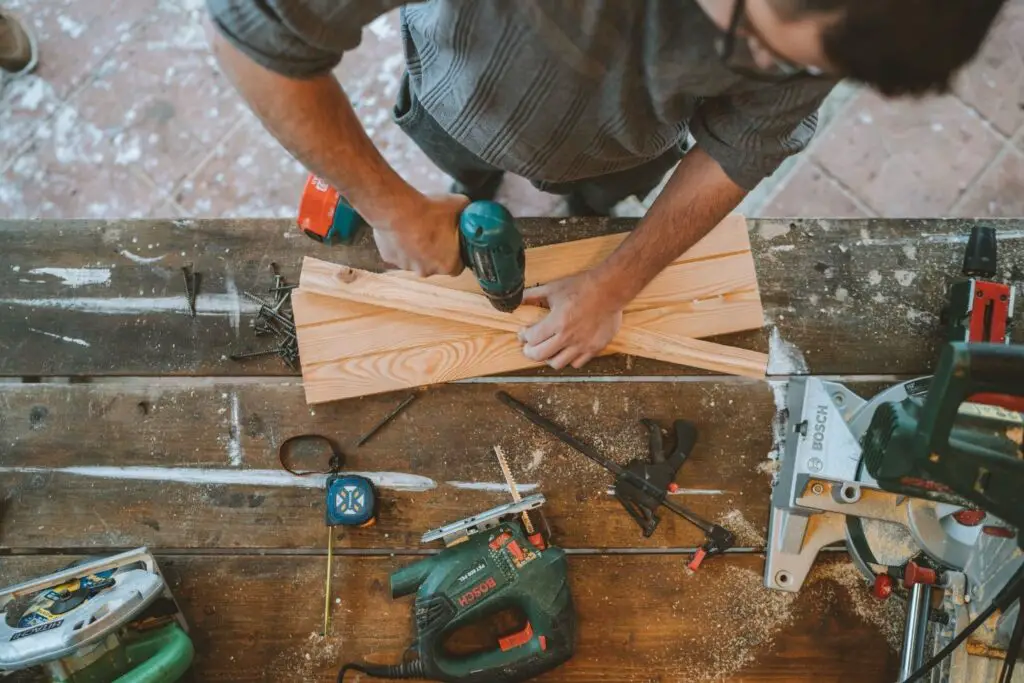
Beginning your work with wood screws may present a challenge, but these tips can help you maximize efficiency & accuracy. Try following these guidelines to ensure that your projects involving wood screws are successful:
1. Pre-Drill Holes
Pre-drilling holes in the wood before inserting the screw is an essential step that prevents the wood from splitting or cracking.
This is essential when working with hardwoods which are more prone to splitting due to their density and hardness.
Drilling a pilot hole is highly recommended when installing screws as it guarantees ease as well as the screws being placed accurately and at the right angle.
2. Choose the Right Screw for the Job
Always ensure that you select the appropriate type and size of screw. Making the right choice guarantees that the screw will hold firmly and not come loose from the wood.
Failure to select the right fit could cause long-term damage or result in costly repairs.
3. Choose the Right Driver
The right screwdriver is essential for correctly and securely inserting a screw. Various types of screwdrivers exist – flathead, Phillips, and Torx – specifically tailored to different kinds of screws. Utilizing the wrong driver may damage the screw and make it tough to fit into place.
Manual screwdrivers may be handy for minor tasks but for tougher projects, a power drill with a screwdriver bit is the way to go; it gives you the necessary torque to insert screws quickly and smoothly and is particularly useful for denser materials.
4. Check For Proper Alignment
To ensure precision in your work, make sure that the components to be connected are suitably positioned before inserting the screw.
To insert the screw, mark the spot with either a pencil or marker by making a small dot or an “X”.
Using a drill guide is an easy solution for ensuring your drill bit goes straight; it keeps the screw aligned while preventing damage to the wood or compromising the structural integrity of the finished product.
5. Avoid Over-Tightening
Working with wood means it’s fundamental to understand how to secure screws accurately without causing damage.
Over-tightening can lead to the stripping of screw threads or cause damage to the pre-tapped threading.
A screw that has been excessively tightened can easily become loose and eventually fall out if the threads are stripped.
There is also a risk of the screw head snapping off with only the shank remaining embedded in the material. This can be frustrating if the screw is in a hard-to-reach location or if the material is fragile or expensive.
To avoid over-tightening, use the correct turning force and quit tightening once the screw is snugly in place.
6. Use Wood Glue Where Necessary
Applying wood glue to the screw hole can help to increase the holding power of the screw, especially in situations where the wood may be prone to splitting or where a particularly strong bond is required.
However, note that glue is not always necessary for every type of joint. For example, in the case of pocket joints, while glue may help to strengthen the joint, it is not necessary as the design of the joint itself already provides a strong connection.
Ultimately, the decision to use wood glue in conjunction with screws will depend on the specific situation and the level of strength and durability required for the joint.
To Round Things Up
Selecting the appropriate type of wood screws is a crucial part of any woodworking project. The market is filled with numerous types, leaving you feeling confused and uncertain about which one to pick.
However, taking into account the factors we discussed such as the type of wood, length, diameter, and strength requirements makes the selection process easier.
Remember to pre-drill holes, use the appropriate driver, and avoid over-tightening to achieve the best results. It is also crucial to opt for quality screws when woodworking.
By following these tips, you can ensure that your woodworking projects will be sturdy, long-lasting, and visually appealing.
